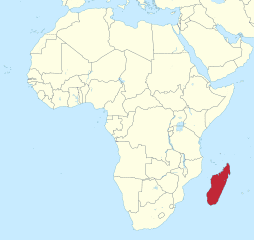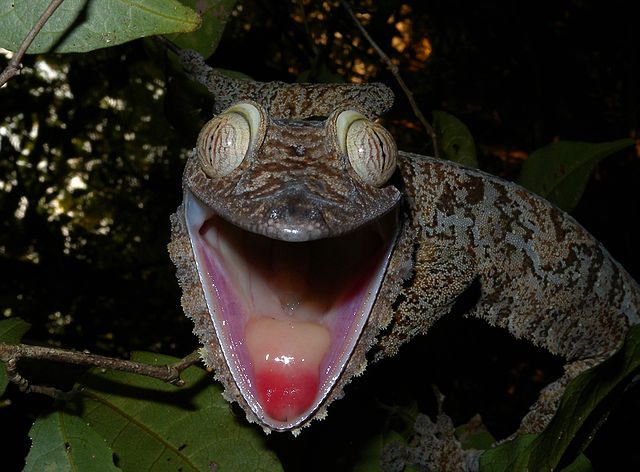In the verdant, untouched jungles of Madagascar resides an intriguingly peculiar creature: the Satanic Leaf-Tailed Gecko, or in the scholarly realms, Uroplatus phantasticus—a portmanteau of Latin terms indicating “flat-tailed” and “imaginary.” As if plucked from the pages of a fantastical narrative, this gecko is a virtuoso of disguise, and when cornered, it retaliates with surprising ferocity, unleashing shrill screams, and determined bites.
Unveiling the narrative of this gecko is like turning the pages of a gripping novel set in the untamed heart of Madagascar. Known for its peculiar looks, unorthodox defense mechanisms, and distinctive dietary habits, the Satanic Leaf-Tailed Gecko occupies a fascinating ecological niche. Its story is an incredible testament to nature’s endless creativity and the intriguing ways in which life can adapt and persist in some of the world’s most isolated locales.
Yet, as enthralling as its tale may be, this unique creature finds itself teetering on the brink of extinction. Human activity and environmental change conspire to threaten the continued survival of this unique species. It is incumbent upon us to familiarize ourselves with these remarkable creatures, their struggles, and the significant role they play in their ecosystem—a mission that this exploration aims to accomplish. Buckle up as we embark on this incredible journey of discovery, delving into the enigmatic world of the Satanic Leaf-Tailed Gecko.
Named in 1888

Accredited to a keen-eyed Belgian biologist, the Satanic Leaf-Tailed Gecko was first cataloged into scientific annals in the year 1888. The naming stemmed from its distinctively uncanny appearance, which might resemble the stuff of myths to the unsuspecting eye. The gecko is endemic to the exotic and biodiversity-rich island of Madagascar, a captivating jewel nestled in the waters off East Africa.
This enchanting island, synonymous with verdant forests and vibrant wildlife, serves as a cradle to a staggering array of gecko species that cannot be found anywhere else on our planet. The leaf-tailed geckos are among the most striking inhabitants of Madagascar’s lush jungles, renowned for their adaptive appearance, often remarkably similar to an unassuming, lifeless leaf.
This master of disguise spends much of its life cloaked in the green tapestry of the forest, skillfully mimicking the patterns, colors, and textures of the leaves in its environment. Its imitation is so exquisite that the gecko becomes virtually invisible among the foliage. Thus, as an adventurous traveler, as you thread through the rich undergrowth of Madagascar’s untamed wilderness, you might unwittingly pass by scores of these cryptic creatures, their presence camouflaged perfectly amidst the tangled leaves.
Locals fear the horny gecko
Labeled as the devil’s own gecko, the Satanic Leaf-Tailed Gecko encapsulates an intriguing mixture of myth, menace, and magnificence. With a crown of horn-like structures, an arresting display of red eyes in many, and a canvas of colors adorning its body, the Uroplatus phantasticus is nothing short of a spectacle in the realm of reptiles.
Unlike the chameleon, celebrated for its ability to transform its hues in an instant, this gecko embarks on a lifelong color-changing journey. As it matures, it gracefully transitions through a spectrum of colors, each phase serving as a milestone in its life. From shades of earthy brown to delicate purples, and even a blush of pink, the gecko’s palette evolves with time, enhancing its prowess at remaining unnoticed in the lush wilderness.
This gradual chromatic metamorphosis is not just an aesthetic wonder, but a pivotal survival strategy. As the gecko ages, it refines its camouflaging techniques, evolving into a master of disguise. This aptitude for concealment is crucial for its survival, considering the gecko’s modest reproductive rate, with the mother laying only a pair of eggs in each reproductive cycle. Consequently, this contributes to the gecko’s rare status.
In local lore, this creature is likened to the devil himself. It may appear unassuming, but this reptile possesses an uncanny ability to switch from being placid to an intimidating protector when confronted with a threat. Imagine embarking on a leisurely stroll through a Madagascar forest, marveling at the lush foliage, when suddenly, a seemingly benign fragment of the tree awakens, unleashes a startling scream, and shows readiness to retaliate with a bite.
The Satanic Leaf-Tailed Gecko, apart from its splendid external colors, holds another intriguing secret. Open its mouth, and you’re met with an abyss, a starkly contrasting black interior that serves as a riveting counterpoint to the vibrant shades of its body. These geckos, thus, are not only an exceptional spectacle of nature’s artistry but also bearers of complex layers of survival tactics and biological marvels.
It’s smaller than you think
At a mere 3.5 inches or roughly 9 centimeters in length, the Satanic Leaf-Tailed Gecko may appear an insignificant player in the grand theater of nature. Its diminutive size, combined with an exceptional ability to blend into its surroundings, makes it a master of camouflage. Yet, despite its unimposing stature, this ingenious lizard embodies the adage that big things often come in small packages.
Under the protective cloak of darkness, the Satanic Leaf-Tailed Gecko embarks on its nightly hunts. Unlike other reptiles who bask in daylight, this diminutive devil’s acolyte has adapted to thrive in the nocturnal realm. With the fall of dusk, it sets out, patiently biding its time until an unwitting prey ventures too close.
And what might be on the menu for this miniature Lucifer’s lizard? The gecko’s palate is far from fussy, embracing a range of night-time delicacies. Roaches, moths, and crickets form the staple of its diet. Snails, too, are a favored treat. In essence, anything unfortunate enough to wander within striking distance of the gecko’s deceptive leaf-like guise is fair game.
Demand in the pet trade
Like a master illusionist, the Satanic Leaf-Tailed Gecko, or Uroplatus phantasticus, has a slew of tricks up its proverbial sleeve. Among other lizards, it’s commonplace to shed their tail as a distraction technique in times of danger. However, what sets this reptilian maestro apart is its uncanny ability to evolve its coloration as it matures, thereby increasing its capacity to blend with an assortment of local foliage. This wondrous creature doesn’t just camouflage—it embodies its surroundings, typically masquerading as an inconspicuous dead leaf.
Spotting a Satanic Leaf-Tailed Gecko in its natural habitat is akin to finding a needle in a haystack, especially without the aid of a seasoned guide. It’s this elusive nature, coupled with an inherently low reproduction rate—usually, a female lays only two eggs per cycle—that has cast a shadow of uncertainty over the future of this species.
The situation is further complicated by the burgeoning demand for this elusive creature in the exotic pet trade industry. Being endemic to the unique ecosystems of Madagascar, the Satanic Leaf-Tailed Gecko finds itself at the epicenter of a conservation dilemma. As its natural habitat shrinks and the pressures of the pet trade continue unabated, speculation is rife about the long-term survival prospects of this extraordinary creature.
It serves as a stark reminder that our pursuit of novelty and uniqueness, albeit well-intentioned, could inadvertently lead to the downfall of species whose existence hinges on the delicate balance of nature. The future of the Satanic Leaf-Tailed Gecko, like many of its peers, is inextricably intertwined with the choices we make today. Will we, as stewards of this planet, ensure its survival, or will we bear witness to its demise? This question underscores a broader conversation about biodiversity, conservation, and our shared responsibility towards the natural world.

Other leaf tailed geckos
The Satanic Leaf-Tailed Gecko, beguiling as it is, is just one member of a fascinating lineage of nine recognized species within the leaf-tailed gecko family. This doesn’t even account for the suspected dozen or more species that remain elusive, tucked away in the dense tropical undergrowth of Madagascar, waiting to be discovered by intrepid biologists.
These captivating creatures, hailed as masters of disguise, are uniquely adapted to the art of hiding. Their gift for camouflage is so advanced that locating them in their native habitats has proven to be quite a herculean task for researchers. Each species exhibits a unique suite of characteristics, displaying a kaleidoscope of adaptations that enable them to meld into their surroundings.
Their sizes vary as wildly as their appearances, with the most petite members barely stretching to 3.5 inches (9 cm), while their larger cousins can boast a length approaching 12 inches (30 cm)—a scale of diversity that underscores the remarkable adaptability of these reptiles.
Perhaps one of the most intriguing features found among these species is the beard-like fringes sported by the larger specimens. These ‘beards,’ composed of soft skin flaps, serve further to blur the line between the creature and its environment, lending an air of rustic authenticity to their leaf-like appearance. The natural world, it seems, never ceases to conjure up fascinating solutions to the eternal problem of survival.

How to find Uroplatus phantasticus?
If your heart yearns to experience the beguiling charm of the Satanic Leaf-Tailed Gecko in its native habitat, it would be prudent to enlist the help of a knowledgeable guide. Hiring a local expert not only supports the local economy but also provides you with an opportunity to unravel the secrets of Madagascar’s unique biodiversity. This island nation, nestled off the southeastern coast of Africa, boasts an impressive 80% endemism rate—the animal and plant life that you encounter here have evolved in isolation and are found nowhere else on Earth!
Opting for a reputable tour operator guarantees responsible, respectful interactions with the island’s natural wonders, including the opportunity to explore the more than 40 national parks and reserves that makeup Madagascar’s conservation estate. Each reserve serves as a refuge for its diverse residents, showcasing a plethora of flora and fauna, including, of course, the star of our narrative, the Satanic Leaf-Tailed Gecko.
Equipped with a keen eye and a camera, embark on an adventure that might morph seemingly mundane shrubbery into thrilling wildlife encounters. Keep a close watch on those desiccated leaves suspended amidst the verdant foliage—don’t be fooled by their inanimate appearance. Amid the rustling leaves and the whispering winds, you may find that the ‘leaf’ you had just dismissed as lifeless might suddenly spring to life, displaying a pair of glaring, fiery eyes and an imposing body that bears the unmistakable imprint of millions of years of evolution.
Indeed, such is the allure of Madagascar—a journey here is an immersion into a world where the line between flora and fauna is intriguingly blurred. It’s a place where leaves might breathe, and where the rustle of foliage might just be the soft padding of a gecko, embodying nature’s profound knack for invention and illusion. Prepare yourself for an adventure that transforms the way you perceive the natural world around you. After all, as you will come to discover in Madagascar, things are rarely as they seem!


